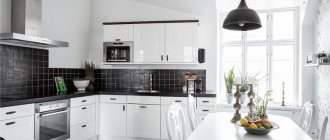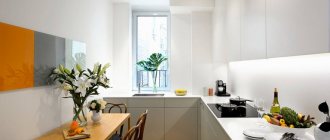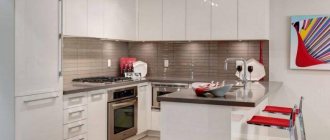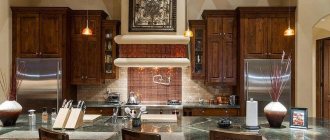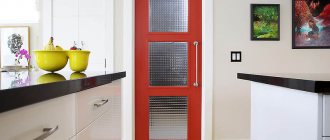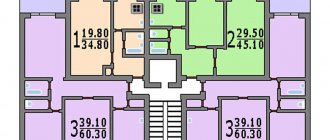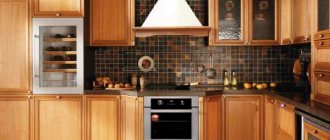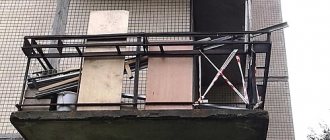The kitchens of apartments, especially those built during the Soviet period, are distinguished by one feature: a large number of communications located in plain sight and spoiling the overall impression of the interior of the room. These are heating pipes and gas communications, “decorated” with various valves and metering devices. The corrugated air duct of a kitchen hood also does not look very aesthetically pleasing. During the renovation process, it is advisable to hide them, while simultaneously improving the ergonomics of the kitchen. For example, in the box above the kitchen shown in the photo, made of plasterboard, you can also place additional lighting. Is it really possible to do it yourself?
Decorating a box using furniture
First, you need to develop a design project for the kitchen.
If the ventilation duct is in the corner and its depth is 60 cm, you can place the wall cabinets of the kitchen unit on both sides. The furniture will be able to frame it, so the kitchen interior will look harmonious. Alternatively, you can paint or glue the structure in the color of the kitchen furniture. Tile the middle between the countertop and wall cabinets (kitchen splashback). Paint the adjacent sections of the wall the same color.
The stove with a hood should be installed near the box. Using the corrugation and the ventilation shaft diagram, you can easily connect the hood to a bulky structure. Another topic: install a sink in the corner near the ventilation duct. Splashes from any contamination will be on the box; this bulky structure will serve as a protective wall. If the ventilation shaft is huge and protrudes strongly from the wall, then it can also be decorated with furniture. In this case, the set must be ordered in the appropriate size. The built-in kitchen option is more expensive.
Some features
When developing a design, you must not forget that if there is a gas stove near the ventilation duct, then finishing it with wallpaper or various types of siding is prohibited. Near the sink you can use moisture-resistant wallpaper or waterproof putty. By examining the location of the ventilation duct in the kitchen, you can select the appropriate material.
The ideal option is a box integrated into the kitchen unit; it is not noticeable to others.
Basically, there is no apartment where you cannot see a ventilation shaft in the kitchen. Usually it is located in the upper side corner of the wall. If you are lucky and have a tiled ceramic apron installed in the kitchen near the stove, then you have the opportunity to harmoniously combine the ventilation shaft with the tiled apron. You will have to line one strip, starting from the apron and ending with the ventilation pipe, with ceramic tiles. The area of the box, which is located above the apron, needs to be made a little lighter and an original pattern applied to it. The remaining free area of the pipe is leveled with putty and painted in the appropriate tone, matching the shade of the surrounding parts.
The ventilation duct can be painted in the color of the kitchen.
The area of the box that does not reach the laid ceramic tiles must be painted in a color that matches the palette of the kitchen interior. If you want to create a ventilation duct in your own kitchen that performs a variety of functions, you can install a plasma TV at the maximum height of the duct. In addition, the mounted ventilation duct will look good with a spectacular picture on which flowers are painted or an original pattern is applied. You will need a cardboard stencil with a beautiful pattern through which you can paint the box. The paint is easy to apply even with a simple spray can.
You may be interested in: How to make a ceiling in a modern kitchen
We are setting up a kitchen in an apartment with 2 and 3 rooms
Apartments with a house layout of number 44 have a square area of 10 meters more convenient, it is easier to arrange everything you need for a comfortable rest and cooking.
A comfortable and functional version of the kitchen space can always be created if desired.
If you have made a corner kitchen, design p 44 will be functional with full arrangement. Place a narrow countertop on the set, install a mortise sink diagonally with one wing or two, as is convenient for you. You won't be able to place a full-fledged nightstand with drawers between the ventilation duct and the sink area, so install a drawer for bottles. In the remaining space, install a hob and two bedside tables, the width of each section is 60 cm.
Results and conclusions
From the information provided, it becomes obvious that when installing an air duct yourself, it is impossible to do without professional advice.
Mistakes made during manual installation of the ventilation duct can ruin the entire structure.
Since modern ventilation systems are expensive, repairs and replacements will not be cheap. Therefore, it is better to immediately contact a specialist.
Decorative box
Materials
Plasterboard profiles
To install or restore a ventilation duct in the kitchen, you will first of all need certain materials, these are:
- metal profiles for the frame;
- sheet of wall or ceiling plasterboard;
- fittings (small self-tapping screws for joining profiles (“fleas”);
- metal screws for gypsum boards (25 mm);
- plastic dowels and screws for them from 50-75 mm (depending on the density of the wall));
- putty.
It is best to make such a frame from 50 mm CW and UW profiles, which you see above in the photo in the upper right corner. The structure you will get is very light and there is no need for a large width of the guides here, and they will take up more space.
It should be noted that the “fleas” used for joining CW and UW can have either a pointed or gimlet end - you are better off with pointed screws. They are easier to work with and the price is the same.
In addition, such fittings are quite small and there are often defective batches where the cross-shaped slot is not made well enough. Therefore, when purchasing, ask (take with you) attachment No. 2 and put a screw on it with your own hands. It must be held on the tip, even if it is tilted 45⁰ “flea” down. Test 3-4 pieces from the batch this way, if everything is in order, the likelihood of quality in further work will increase significantly.
To attach the frame to a wall or ceiling, you will need plastic dowels 6 mm in diameter and screws. If the wall has lime-sand plaster, then the length of the screw can reach 75-90 mm, so that the dowel can be located in brick or concrete.
In cases where the wall is finished with cement-sand or cement-lime plaster, as well as any of the putties, the instructions allow using a length of 50 mm. This will be quite sufficient due to the low mass of the ventilation box and sufficient wall density.
Plasterboard sheets (GKL)
Considering that the creation, increase or decrease of a ventilation duct in the kitchen is made from the same materials, it is better to choose the latter when choosing between wall and ceiling plasterboard sheets. Unless you still have wall gypsum plasterboard from a previous renovation.
The fact is that gypsum plasterboards have quite enough strength for such a design, since you only need to remove the ventilation duct from view, but it costs much less, and it’s easier to work with due to its low weight.
Nozzle for gypsum plasterboard
Nuances of installation work
Frame on the ceiling
- First of all, you will need markings, and here some netizens are interested in the layout of a kitchen with a ventilation duct in the corner, but it should be said that a kitchen with a ventilation duct in the corner can only exist when there is a hob in that very corner. In any other case, the structure will rise vertically along the wall to the ventilation duct. And if it is to the side, then having reached the ceiling, the box is turned towards the channel window at an angle of 90⁰ directly along the ceiling.
- If you have problems with how to use an exhaust air duct around a pipe, then you will have to increase the depth of the frame, since this is the only way to hide the contour without spoiling the design. Do not be afraid of increasing the depth of the box, because this will in no way affect the usable area of the room - the extensions will be above the exhaust hood or on the ceiling - both will not affect your work space.
Installation work
- Do not try to follow the trajectory of the air duct, unless this is part of the design intent - this is sometimes done in combination with figured suspended ceilings or arches. But this is possible either on special or old building projects, or in mansions where the ceiling height exceeds the usual (can be from 3m to 3.5m), and in all other cases the box will have a vertical, or L-shaped, or T-shaped form. A T-shaped design is necessary in cases where a heating bed runs parallel to the air duct, since they will have to be decorated together.
- Before pasting the structure with wallpaper, putty or during it, a metal perforated corner must be attached to the corners of the box - this is how the structure acquires clear geometric shapes.
Varieties of design
I would like to dwell a little on what shape a kitchen box for a hood can be. This will help everyone decide what suits them best. After all, there is no universal recipe, since the layout of kitchens can be different, and everyone has their own concept of beauty.
For some, a vertical square box will be the ideal solution. For others, this will turn out to be absurd, because there is nothing more beautiful than a compact rectangular box under the ceiling. Before you assemble a plasterboard box, you need to understand what it should be like.
- Plasterboard box for built-in hood. In this case, only the lower part of the hood is visible, since everything else is hidden behind the drywall. The design does not seem bulky.
- The hood is completely visible, and the box starts from its top and goes to the ventilation window.
Everyone decides for themselves which option to choose.
How to fit an air duct into the interior
Scheme of a kitchen with a ventilation duct in the middle of the wall.
The ventilation duct can be partially or completely covered by kitchen units, such as lower and upper cabinets. To do this, you should order kitchen furniture individually, according to the specified dimensions.
A large box can be disguised using finishing materials, turning it in this way into an additional decorative element. In this case, nothing can be done about the ledge; there is no question of saving space, but the external design of the kitchen interior is significantly improved.
A particularly good solution for masking the air duct would be to use the same facing materials as on the adjacent surfaces of walls and furniture. Wallpaper, tiles, paint and others are great. As an option, plaster it in the same tone as the ceiling, or completely tile it from top to bottom.
An even more “advanced” disguise option is to imitate the appearance of kitchen cabinets, i.e. make a kind of decorative pseudo-set. Photo wallpapers with beautiful designs will look good.
The result will be something like a decorative art object in the style of a patchwork mosaic; few will even guess that this work of art is actually just a ventilation shaft. Proper installation of lamps also helps to divert attention from design flaws.
Scheme of the box for the air duct.
Another option is to use decorative wall panels that match the style of the interior, for example, imitation brickwork or glass panels with photo printing. Thanks to this approach, the ventilation duct can easily become the compositional center of the kitchen decoration.
Another element of the ventilation system that often causes inconvenience in the kitchen is the hood duct. A kitchen hood is also sometimes difficult to integrate into the kitchen interior due to its upper air-ducting parts. Even a corner exhaust system requires masking of the elements. Installing a hood box in the kitchen is the optimal solution to this problem.
Many different materials are suitable for constructing the box, mainly plasterboard, plastic panels or plywood. Glass is not recommended. The dimensions of the structure must correspond to the dimensions of the exhaust device. You can decorate the facade of the box in various ways, for example, by making swinging doors in it.
Materials required for installation
Profiles UD and CD
The basis for installing a ceiling box is a frame made of a metal profile; for it you will need:
- guide profile UD;
- supporting profile CD;
- brackets and crab connectors;
- fastening materials (screws, dowels);
- sheets of plasterboard 12 mm thick, corresponding to the humidity level in the room;
- primer;
- gypsum putty;
- mesh for seams.
When choosing a material, you need to pay attention to its quality: the plasterboard sheets should not be chipped, the galvanization of the surface of the profiles should be uniform. The rigidity of the metal frame ensures the safety of the entire structure; it is better to purchase material from well-known manufacturers. Fasteners and profiles must be of the same brand.
Box drawing
Before installing the box, you must complete a drawing that will allow you to calculate the amount of material required.
Until sheathing, the sheets are stored only in a horizontal position.
Design options for rooms with a ventilation duct
The area of a typical kitchen in rare cases exceeds 10 square meters. m. Therefore, squeezing all the necessary kitchen equipment into such a limited space is already a task.
What can we say about those cases when part of the area is “stealed” by the kitchen box. And the first thing you should understand is that there is no way you can get rid of this protrusion, and therefore all ideas related to dismantling should be cut off immediately.
Therefore, the only option in this case is to decorate the space so that the kitchen becomes as functional and beautiful as possible. Naturally, in this case, the best way out of the situation would be to manufacture custom-made furniture.
Nowadays, there are a large number of different workshops that professionally manufacture kitchen sets (see also the article Design of a kitchen set: what to choose).
You can visually hide the projection of the box using:
- bar counter,
- shelves,
- cabinet, etc.
The custom-made set perfectly hides the protrusion.
Decorating the ventilation duct
A kitchen project with a ventilation duct in most cases involves decorating the protruding part of the wall. You can do these works yourself, because they are all simple and can give a unique look to your kitchen.
If the ventilation ledge cannot be removed from the room, then the best design option is to present it as a stylish accessory.
The instructions for creating interiors in rooms with a ventilation duct provide several options:
- A small ledge can be decorated as an authentic column made in the Mediterranean style (see also the article on decorating a kitchen set with your own hands). To imitate brick or natural stone, you can use gypsum tiles. It can be laid either on liquid nails or on special tile adhesive, and the wall surface does not require special preparation.
- You can create an accent using wallpaper and textured paint. Using photo wallpaper is also a good option. The purpose of this method is not to hide the protruding wall, but to expose it in such a light as if this element of the room was specially conceived (see also the article Photo wallpaper for the kitchen is back in fashion).
If there is a sink in close proximity to this ledge, then use washable wallpaper. They are washable, not moisture-resistant, since the latter simply cannot maintain their original appearance in conditions of high humidity.
- One of the walls of the box can be used as a large slate board, on which it is very convenient to place spontaneous notes. At the same time, you can purchase a ready-made version or cover the protruding surface with special paint.
- If the ledge is located near the stove, then it can be combined with a tile apron.
A ventilation ledge designed as a continuation of the kitchen apron.
- One of the simplest options is to integrate a protruding surface into the kitchen furniture. For example, it can be hidden in a wall cabinet, following the example of a kitchen hood. This type of camouflage is the best option, since in this case you can completely hide the protrusion.
- The ventilation duct can be decorated as a fireplace. However, it does not have to be an electric fireplace. Very often a dummy is used. If such an imitation is done with high quality, then it will certainly fulfill its aesthetic function.
Using the box as a functional element
Decorating the ledge under the fireplace.
- You can also place a plasma TV on the ledge of the box, which will be a stylish addition to the kitchen interior. The TV can be mounted on the wall using a flexible bracket. This is especially true for kitchens of medium and large sizes, where a rotating screen would be useful.
- A similar design can also become the basis for a bar counter. In this case, it can be presented not just as an active element of the interior, but as a specially planned one. In a small kitchen, a bar counter can be an excellent replacement for a dining table, and therefore significantly save space. At the same time, you can provide your kitchen with a stylish and modern element.
For a small kitchen, it is best to use a bar counter with stools, which can be easily hidden under it if necessary.
Kitchen ventilation systems: natural or forced
Not everyone knows which ventilation scheme for the kitchen is better: standard natural, when exhaust gases exit through a duct to the street, or forced (a fan is used to remove contaminated oxygen). There is no definite answer to this question, because each of the hoods performs its own functions and has its own advantages and disadvantages.
In the kitchen, regardless of its location (in an apartment or a private house), the presence of a natural ventilation system is mandatory. Particular importance should be paid to the performance of the equipment, and especially if there is a gas stove in the room. In this case, harmful emissions will be discharged through a vertical natural ventilation channel. The exhaust rules do not consider forced ventilation to be a mandatory engineering service; it only ensures the comfort of residents. Next, we will describe each type of air exchange in more detail, consider their strengths and weaknesses.
Natural ventilation in the kitchen
Exhaust ventilation in the kitchen is familiar to all residents from vertical shafts that have an exit on the roof of a residential building. Harmful substances and fumes are removed through such passages, and fresh air enters the premises through cracks in the windows or special valves on the frames. Warm air heated by the kitchen stove tends to rise, it accumulates on the ceiling and goes through the ventilation hole outside the house. In its place, fresh oxygen comes from the street.
Proper, high-quality ventilation for the kitchen in an apartment removes a small amount of waste gas, but does this in a constant mode. A ventilation duct cleared of debris is capable of removing carbon monoxide and minor fuel leaks from kitchen equipment. To effectively remove foreign odors, a hood must be mounted above the stove.
Supply ventilation has the following advantages:
- high-quality air exchange in the apartment;
- removal of harmful substances that are released during cooking;
- removal of odors and high air humidity when several burners are turned on;
- lack of financial investments for the operation of the system;
- noiselessness.
Ventilation in the kitchen with a hood has the following disadvantages:
- decreased performance in hot weather;
- the possibility of air return from the street into the kitchen;
- relatively small volume of processed air per unit of time;
- you need to constantly check the draft in the ventilation duct.
Not all owners of country property know how to properly install a natural ventilation system in a private home. In this case, the channels will be made in the walls of utility rooms, such as the bathroom, toilet and kitchen. For high-quality ventilation of the entire house, and not just these rooms, it is necessary to additionally let in air flow from the bedroom, living room or dining room. In some cases, you need to keep the windows open.
If a four-burner gas stove is installed in the kitchen, then the hourly volume of processed air should be within 90 m3. For efficient operation of the ventilation system, it is necessary to install a channel with a cross-section of 0.02 m2. This parameter corresponds to a pipe diameter of 16 centimeters or a shaft made of brick in the shape of a square with a side size of 14 centimeters. The entrance to the channel is located on the ceiling or at a distance of 20-30 centimeters from it. To ensure stable draft, a ventilation duct of at least 5 meters in length is needed.
Forced exhaust system
The term forced ventilation refers to an engineering system in which contaminated air flows are removed outside using a fan. In the kitchen, such devices are installed using different methods:
- In the vertical ventilation shaft.
- In a hole made in the wall of a building. In this case, the polluted air will be discharged from the kitchen outside, bypassing the ventilation shafts.
- A corrugated pipe from a kitchen hood can be inserted into a window.
- Some consumers install a special device, a hood, above the gas stove. Polluted air can escape from the kitchen into natural ventilation shafts or directly into the street through a hole in the wall.
The advantages of connecting an exhaust fan or kitchen hood are:
- Improved performance. Effective ventilation in the kitchen allows you to quickly remove odors and harmful substances accumulated in the air.
- A kitchen hood above the stove removes harmful substances before they enter the room.
The disadvantages of the hood device are:
- Dirty air is removed from the room only when the fan is running.
- Such a system requires financial investment. In addition to the cost of the hood itself, you will have to constantly pay for the electricity consumed.
When installing a fan in a shaft, there are several important points to consider. The fact is that such a device has a check valve that prevents the suction of dirty air when the hood is not working. This valve must be removed so that it does not interfere with the operation of the natural air exhaust system. It should be noted that the performance of the device will coincide with the passport data only if a horizontal outlet channel of short length is installed. A modern hood connected to a common house shaft will have lower productivity compared to the declared technical characteristics. Ventilation diagram in the kitchen with a hood
Options for masking the ventilation duct
Let's look at the examples in the photo.
1. In this photo you won’t immediately notice the box, although it is clearly more than 60 cm: it was successfully disguised with plasterboard, creating a convenient niche in which an entire closet fit.
2. In the next photo, the small ventilation duct, up to 60 cm on both sides, is a continuation of the kitchen apron.
In each specific case, the choice of the optimal solution depends on a number of factors.
You will have to choose among 3 options:
We furnish furniture to order
If the ventilation duct is located in the corner, our task is simplified as much as possible, since it can be played with furniture and neatly fit into the overall interior of the kitchen. The ventilation duct will save us from the need to use the inconvenient corner area, which is usually reserved for the sink. Thus, our yesterday's flaw will become the starting point for designing a corner or linear kitchen.
Can't decide on the color of your kitchen? A red kitchen is a bold and original solution! Interior design and photos.
If you like oriental motifs in the interior? Then this article is for you!
Do you have a white kitchen and don't know how to add originality to it? The answer is here.
We decorate (finishing)
If the kitchen layout does not allow you to “make friends” with the ventilation ledge, that is, use it functionally or fit it into the furniture, you will have to use more imagination to turn yesterday’s flaw into an original design solution, the central element of the kitchen.
Learn more about kitchen layout with ventilation duct. Advice from professionals!
How to come up with an interesting kitchen design with a ledge? Ideas, photos, tips here.
If you are wondering what styles can be played in the interior of the kitchen? We've found the answer!
Let's switch to antiquity and, with the help of decorative finishing, recreate some kind of authentic Mediterranean column from it. To achieve the desired effect, you can use gypsum tiles, imitation of natural stone (brick)
And it doesn’t matter in this case where the ventilation duct is located - in the corner or in the middle of the wall. On the end wall of the ventilation duct, you can install either a real fireplace, if space allows, or a false fireplace. As a bonus, you get an additional element of warmth and coziness in the kitchen with an emphasis on the Victorian era. We mask the ventilation duct, finishing it with the same materials as the adjacent areas of the kitchen wall
This could be tiles, wallpaper or textured paint. By skillfully combining texture and lighting, you can ensure that the protrusion becomes invisible. A mirror in the kitchen is not a frequent guest, but if a mirror surface on the walls of the box will help visually expand the kitchen and hide a defective ledge, then why not? We bring the ventilation duct to the central plan. To do this, you can use not a monotonous, but a multi-colored finish. Mosaic tiles, two-level finishing with different materials will help to focus attention on our ventilation duct, if there is no escape from it. The finish can also be tailored to the functional use of the ventilation duct wall.
Finding functional applications
In conditions where kitchen space is limited and the kitchen layout cannot be changed, you can try to benefit from a large ventilation duct by coming up with some use for the latter. Here are a few options:
- One of the walls of the ventilation duct can be used as a platform for a plasma panel.
- If the ventilation duct is located next to the kitchen work area, you can set up a testing ground on it for hanging kitchen utensils and textiles.
- Alternatively, a conventional ventilation duct column can become the starting point of a bar counter or a small dining table.
- A small niche between the wall and the ledge of the ventilation duct can be used as a mini-pantry for a trash can, equipment and kitchen utensils.
So, there is no need to “fight” with the protrusion of the ventilation duct, because you still won’t be able to get rid of it. And if at one time Michelangelo made a statue of David from a block of stone, then what’s to stop us, with the current level of technology development, from reworking the ventilation duct in such a way that it would benefit the design and would not affect the layout of the kitchen.
In some kitchens, part of the space belongs to the ventilation duct. It becomes a design problem
It is important to take into account all the nuances in order to beat this circumstance profitably. The design of a kitchen with a ventilation duct involves many features
Useful recommendations will help you create a beautiful interior.
What is a ventilation duct in the kitchen?
Kitchen with a ventilation shaft
The components of the box are a ventilation hose, air inflow and outflow valves connecting to the general ventilation shaft of the building. It can be located in the corner, at the entrance, in the center of the kitchen. Most often - in a corner, near communications. This option is most convenient for arranging a kitchen with a ledge. If it is located along the wall or near the door, you will have to work hard to solve this problem.
The design takes away useful meters, disrupts the geometry of the kitchen, and complicates the arrangement of furniture and appliances. But it cannot be dismantled, since the system throughout the entire house is the same - natural ventilation will go wrong:
- A shaft consisting of boxes installed on top of each other will lead to loss of support on higher floors.
- The lower apartments will lose air exchange.
The ventilation of each room belongs to the general house system, so the law does not allow private adjustments.
Purpose of ventilation ducts in the kitchen
The main purpose of the air duct is to ensure safety, cleanse the kitchen atmosphere, rid the room of gas, food odors, soot, overheated air and other emissions generated during cooking.
Ventilation shaft design
Flexible hose
In old apartments, the gas pipe went directly to the stove or water heater. Good news: it is now allowed to connect gas equipment with a flexible connection specifically designed for this purpose. Now you can legally cut the gas pipe in the kitchen (to the tap) and install a hose. Flexible wiring, especially metal corrugation (bellows), can look much better.
The length of such wiring (up to 3 meters by law) is also not a problem; there are hoses of different lengths, or two hoses can be connected. But there must be access to all connections.
A flexible hose is much easier to cover than a pipe in a variety of ways.
A good idea is that the hose from the wall cabinet to the table top can be passed through a chrome pipe (table leg), which will fit into the interior. But it must remain removable.
If you have a countertop made of artificial stone, you can use a removable “corner” made of the same material to cover the hose in the corner of the kitchen.
How to improve an air duct
It is not without reason that a protruding ventilation duct is considered a significant drawback, as it takes up useful space in the room and complicates the process of decorating the space. But it can be turned into a decorative element, thereby creating an original and unique interior. Horizontal pipes or casings located at the top will not interfere with the housewife. They hide easily and do not create any problems. But the design of a kitchen with an air duct permanently installed in a vertical position must comply with the requirements of not only aesthetics, but also ergonomics.
Vertical ventilation ducts can be placed in a corner, along one of the walls or near a doorway. They have a square, rectangular or arbitrary cross-section. By size, there are large air ducts, more than half a meter deep or wide, and small ones - up to 50 cm deep or wide.
Camouflage options
The most convenient way to design a kitchen space is a corner ventilation duct. It is furnished on both sides, allowing the structure to almost completely disappear from view. The visible surface of the air duct, located between the two tiers of cabinets, is finished with the same materials as the kitchen apron. Thus, the box becomes a continuation of the area above the countertop.
It is very easy to camouflage an air duct located at a distance of at least 60-70cm from a corner. It is covered with plasterboard, after which the surface of the structure is painted to match the furniture facades. Custom-made cabinets are installed in the created niche. It is not recommended to place a refrigerator there, since you will have to additionally solve the issue of ventilation. Otherwise, household appliances will not last long.
Methods for selecting a zone
If the air duct cannot be visually hidden, then you should try to focus on it. In this case, the box can become the central design element. But to implement such an idea you need to show imagination.
Here are several options for finishing the surface of the protruding air duct:
- creating an antique column - materials that imitate the texture of stone are suitable. Contrast with the walls will give a good effect;
- installing a flat decorative fireplace on one side of the channel - you will need a large kitchen area;
- using the same colors and shades as for the walls, but materials with different textures;
- application of the effect of mirror surfaces;
- gluing bright mosaic tiles in a chaotic manner, in the form of an ornament or design.
Functional solutions
Since the vertical air duct is a stationary structure that cannot be removed, it should be used to its maximum advantage. For example, you can hang kitchen utensils on one of the walls or place a plasma panel of the appropriate size on it. The small niche formed between the wall and the ventilation duct will perfectly accommodate any household items:
- detergents;
- washing powders;
- rags;
- buckets;
- mops, etc.
The air duct may well become part of a bar counter or dining table. Nothing will prevent you from placing small shelves with decorative plates on a durable box or decorating the surfaces with unusual lighting. The inevitable reality must be taken for granted, turning disadvantages into advantages, and disadvantages into advantages. There are a lot of design options for air ducts, so you shouldn’t be discouraged that the design is in the way. A little imagination - and the owner will certainly be able to be proud of his renovated kitchen.
Styles
There are quite a few ways to play up the ledge of a ventilation box: this can be done using various materials and decorative elements. However, it is always worth starting from the style of the kitchen space.
If the kitchen is made in country or Provence style, this is a reason to think about making the protruding part of the air duct the main “attraction” of the room. To do this, you can use fresco painting on plaster, which is suitable for this room due to its durability and resistance to temperatures and high humidity. In addition, it is beautiful as a decoration. There is also the option to make decorations in the form of panels or mosaics using ornaments and geometric shapes from metal puzzles, which is suitable for styles such as modern, high-tech or loft.
Tile is an equally relevant option. When the box is located on the same level as the kitchen apron, you can suggest finishing these areas with tiles of the same or contrasting tone. However, there are other variations, for example, arbitrary combinations of tiled fragments of dark and light shades, which will support any modern interior style.
To design a ventilation ledge in an industrial loft style, you will need tiles that imitate brick or any natural stone, but you can always get by with ordinary cement, creating a fashionable uneven texture. Of course, the surface of the box should harmoniously match the walls and apron of the kitchen.
Using reflective panels or mirror elements in a small kitchen, you can not only cover the pipe, but also visually increase the space.
In addition, you can make this “inconvenient” part of the room beautiful and functional with the help of sheets of drywall. The main idea is to create several niches in which it would be appropriate to place decorative elements or small kitchen utensils, for example, unusual dishes. In a spacious kitchen room, it makes sense to install a fireplace portal structure or a false fireplace at the bottom of the ventilation ledge, simulating a real device, only without a chimney.
An original way to distract attention from the wall with a ventilation ledge in a kitchen in a modern style and black and white interior colors is to apply a hard slate coating to the box, on which you can write and draw, like on a blackboard. A complement to this sophistication can be black and white posters on the wall near the dining area or wall and floor tiles in the same shades
The simplest design method is painting in the same tone as the color of the kitchen unit, this allows you to combine all parts of the kitchen into one whole. Moreover, such camouflage works for any cross-section and shape of the air duct.
Sometimes the air duct does not need any secrecy or decoration at all. If residents prefer stylistic trends such as art-poveri or techno, it is enough just to highlight or emphasize the industrial look of the box with the help of suitable lighting, color and texture.
Of course, all these design options must be correlated with the style, but they also need to be implemented based on the layout, size of the area and its color palette.
